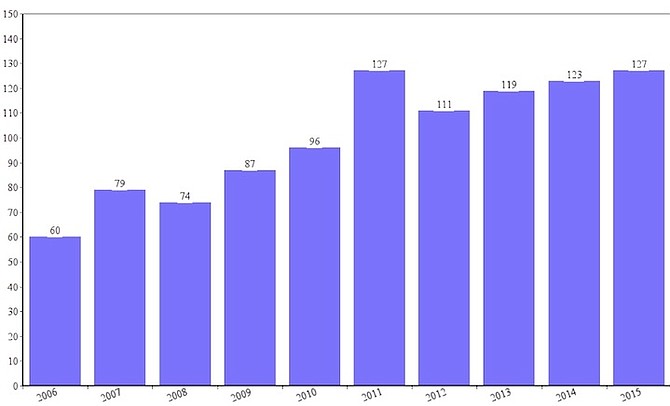The murder totals year by year in The Bahamas - including 127 so far in 2015 with a little under two months remaining.
By RICHARD COULSON
I am not a criminologist. Nor am I a cop, a judge, a prosecutor, a public defender or a prison warden.
I have only rarely been a victim, once having been mugged and lost my car and wallet stolen by three thugs – about par for a Nassau resident.
So I am no expert on crime prevention. But like any thinking person, when I read almost every day a story about another killing (more technically a “homicide”), I am appalled as the figures rise and I begin to think what might be done.
First thing I ask is, where do we stand comparatively? I don’t compare us with Switzerland or Denmark or any other placid white-bread paradise, or even with the United States as a whole. I compare us with New York City, a gritty, polyglot metropolis mixing every race and nationality with the richest of the rich and the poorest of the poor, about 8.5 million residents committing every conceivable crime flowing through its 123 police precincts, five county courthouses and half a dozen prisons.
And I find our statistics are a lot worse than New York’s.
In 2014, 328 murders were recorded citywide, or roughly 3.85 per 100,000 population, the common standard. Here in The Bahamas, we are on the way to an unprecedented 150 murders in 2015, on 360,000 population, or about 42 per 100,000, more than last year and marking a steady upward trend.
The common reaction to this comparison is to throw up our hands in despair and lament that government simply does not have the resources or the will to correct it. But we should look at another statistic: in 1990 New York City was facing a crisis as it recorded 2, 245 murders, nearly eight times last year’s total, and the figure has gone down almost steadily every year since then, giving the Big Apple a new reputation as one of the world’s safest cities. If big, bad New York City, with every variety of urban problem, can shrink its crime rate, why should we be discouraged about doing the same?
Many theories have been given to explain New York’s success. Particular credit has been given to William Bratton, who became Transit Police commissioner in 1990 and then city-wide Police Commissioner (to which he was reappointed by the new Mayor just last year). He is credited with a detailed crime analysis system known as CompStat and also with the so–called “broken window” policy, which holds that vigorous enforcement of “quality of life” misdemeanours – breaking windows, littering sidewalks, public brawling, etc – results in reduction of serious crimes like assault and homicide.
It’s notable that his first act was obliterating the graffiti that, for years, had defaced New York’s subway cars, with an immediate drop in subway crimes. Doubtless our experienced Commissioner Greenslade is aware of these developments, but probably constrained by budgetary limits or political interference. In New York City, the Commissioner reports directly to his boss, the Mayor, not to an intermediate “minister of national security”, a well-meaning politician with no law-enforcement background.
Another useful step would be a closer analysis and publication of the categories of homicide, and of the victims themselves. A certain portion could be identified as spontaneous crimes of passion, and another marked as crimes for financial gain – robberies or hold ups. But we most often read about “drive-by” crimes, where hit-men shoot down a bystander and speed off taking nothing. These can only be categorised as power fights, usually a pay-back in a turf battle between rival gangs dealing in drugs. How prevalent is this type of murder? It seems surprising that our CID has not already amassed a trove of information about gang composition in our small community and cannot quickly track down the culprits, and thus solve many of these killings.
While in the eyes of God and the law every victim is of equal worth whose death is entitled to an equal investigation, over-worked police officers may have a somewhat different scale of values when the victim himself is a guy with a known criminal record, with a string of offences and actually out on bail for a serious felony.
Years ago, when I worked for a year with the NYC Police Department, I got friendly with a couple of senior detective lieutenants who told me some hard truths that “civilians” are never supposed to hear. While no murder case is officially “closed” until solved, they pointed out how in practice a murder investigation can vary between a maximum full-court press and one that just goes through the motions and then is dropped. Most victims and their families get the benefit of the former treatment, but if it’s a case of a soldier from one drug gang being whacked by a soldier from another gang, the detectives are not inspired to work overtime for an indictment of one bad guy who has eliminated another bad guy.
Of course, that distinction was never openly admitted in New York, and I do not expect that it will ever be admitted in Nassau. But realistically, we citizens should be aware of this theoretical flaw in criminal justice. If crime statistics gave us some information about the frequency of “drive-by’’gang killings (even if we cannot expect them all to be solved) we would have a better understanding of the reality of our policing problem. I hope our force can find the resources to prepare detailed profiles of each homicide and its victim – and publish them. A recent piece in The Tribune by Andrew Allen underlines glaring deficiencies in our judiciary system. The principal one is the propensity to grant bail, even to multiple offenders who may already be on bail for a separate felony. Mr Allen notes that our judges, politicians and defence lawyers continually emote about the sacredness of individual rights and rarely invoke the rights of society and the public interest.
We certainly never hear proposals for restricting jury trial, a move to reduce the frequent suborning of jurors in high-profile cases.
His column also hints at the inadequacy of the court structure and the work ethic of our magistrates. I recently scanned the 2014 Annual Report of the New York criminal court system, a massively detailed document covering a huge enterprise that hires nearly 75 judges and thousands of clerical staff running dozens of courtrooms in five county courthouse complexes. The system is mandated to bring an accused from arrest to arraignment in no more than 24 hours. As there can be as many as 1,000 appearances a day, it is a hugely complex undertaking, each arraignment requiring that a detailed “rap sheet” together with the accused, a prosecuting district attorney and defence counsel (often legal aid) be physically brought before a judge who makes an immediate disposition - release, fine, prison or transfer to a higher court. Administrative Judge Melissa Jackson boasts in her summary that the work gets done by keeping the criminal courts open from 9am to 1am, not just for a five-day week but 365 days a year!
I wonder how Bahamian devotion to holidays would tolerate any similar system? At the very least, will it ever be possible to prepare and publish online a similar Annual Report, whose final page shows down to the last dollar the sources of the total $31,984,659 received by the New York courts in fines and other charges, covering part of the courts’ $126 million budget?
We are far from reaching this level of fiscal transparency.
• Richard Coulson is a retired lawyer and investment banker born in Nassau and from a long line of Bahamians. He is a financial consultant and author of A Corkscrew Life - adventures of a travelling financier.






Comments
jus2cents 8 years, 5 months ago
Another Excellent article Sir! Thank you.
Lack of Enforcement of the Law is the single biggest issue facing this nation.
Enforce and apply the laws swiftly and the nation will be better off all around. (We will need a new prison though)
The judicial system here (Or Lack of!) is horrendously poor. Many of the Judges are tardy, lazy, careless and arrogant. They allow the lawyers to be lazy, unprepared and late to court as well, so much time is wasted, it's a crime in and of itself. Although I do feel sorry for the few good Judges & Lawyers, their hands are tied by the inept system.
TruePeople 8 years, 5 months ago
The thing is there seems to be a very stereotypical and polarized view of criminality in this country. the criminal is the young poor black man who due to his social and economic limitations and frustrations is committing brazen acts in the streets.
But criminality in the police force, the justice system, and the political elite is glossed over.
Ghetto youth steals a handbag and gets shot to death VERSES Politician pockets 100,000s of $ of public monies, kickbacks and bribes, and gets re-elected
The thing is, the street gangs and the politicians are closer than you think, so it's actually not in their best interest (in their skewed point of view) to eliminate them...
digimagination 8 years, 5 months ago
Always enjoy reading and digesting your spot-on articles!
Sign in to comment
Or login with:
OpenID